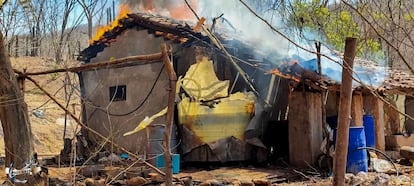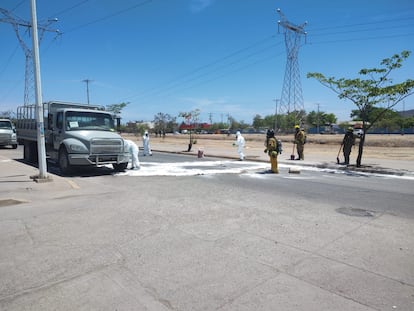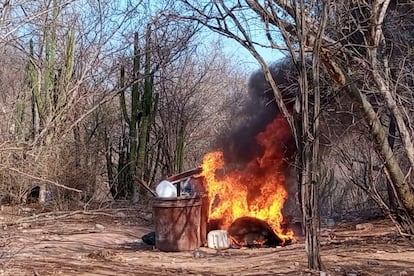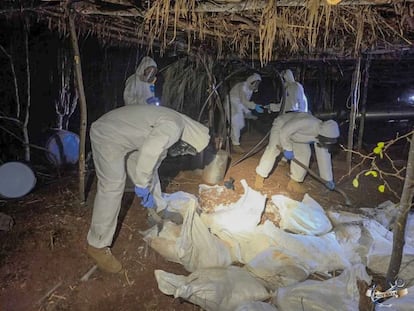Cooking an environmental catastrophe in Mexico’s illegal drug labs
Thousands of clandestine labs to manufacture synthetic drugs are dumping tons of toxic chemicals into Mexico’s most fragile ecosystems. Who is in charge of protecting the environment against the growing number of these laboratories? Quinto Elemento Lab investigates

You don’t have to walk far into the Nuestra Señora Nature Reserve to see plastic trays, containers, and even gas cylinders scattered in the wilderness. Some float in the water, trapped where the river bend catches debris from upstream. They’re the remnants of synthetic drug production, washed down by rain from narco-laboratories high in the Sierra Madre of the western Mexican state of Sinaloa. The chemical odors they bring seem otherworldly in the pristine environment.
Mauro Aguirre Zazueta, an environmentalist studying endangered flora and fauna in the mountainous municipality of Cosalá, sees it all the time. “They carry acids and they are very dangerous; if you spill them on a plant, the plant won’t survive for long, it will dry up,” he explained.
It’s a narco-made ecological catastrophe. With an epidemic of addiction in the United States, synthetic drug production in Mexico is higher than ever. While the health impact of these drugs is well quantified — around 110,000 overdose deaths in the U.S. from January 2022 to January 2023 — the environmental damage from the chemical wastes remains unknown.
An investigation by Quinto Elemento Lab found that Mexican authorities responsible for the cleanup and prosecution of illegal chemical dumps have not intervened in a single case of contamination caused by clandestine laboratories.
It’s not due to a lack of information. According to the Mexican military, the number of labs discovered and decommissioned has increased 16 times in the last 5 years, from 58 in 2018 to 948 in 2023. In total, 2,079 labs have been discovered during the presidency of Andrés Manuel López Obrador, three times more than in the previous administration, according to figures from the National Ministry of Defense (Sedena).
The number of dismantled synthetic drug laboratories in Mexico by location and year. Source: Quinto Elemento Lab with data from the National Transparency Platform of the Defense Ministry, National Guard and Mexican navy
The military also reported the seizure of 488,707 kilograms and 1,215,000 liters of chemicals and precursors from these laboratories since 2018, enough to fill 17 large shipping containers and more than 40 fuel tankers with poisonous chemicals capable of causing everything from temporary disabilities to death, depending on exposure.
As one example of the impact, Mexico seized nearly 556,308 kilograms of methamphetamine between 2018 and 2023. The UN estimates at least six kilograms of waste for every kilogram of meth produced illegally.
Chemicals used in the production of synthetic drugs kill plants and trees around the labs, while their wastes are either carried away by water or end up in the soil, posing latent risks to animals and people. Experts say that contaminated areas can take up to 25 years to recover.
“At times, we have found that the laboratories dump hazardous substances, reactor residues, and residues from the synthetic drug production process onto the ground. Therefore, an isolation process must be carried out to prevent contamination of livestock, people, or our water sources,” said Mexican army General Alfredo Salgado Vargas, a recent commander in Sinaloa.
But it’s not clear that process is being done. Quinto Elemento Lab’s information requests to the National Platform for Transparency found no government assessments of this environmental damage. There is also no evidence of protocols for first responders arriving at laboratories, for those who seize hazardous substances, or for those who should be charged for ecological damage.
Instead, the federal government’s strategy under López Obrador has been to deny that Mexico produces fentanyl, the newest, most lethal synthetic opioid pouring over the border into the United States.
People exposed to these chemicals — and whom the authorities are responsible for protecting — know the dangers when they find dead livestock near a contaminated water well, or a mangrove where fishing is no longer possible, or see chemical explosions in a warehouse or spills on the road. As recently as May, soldiers investigating a lab in the Sinaloa community of El Pozo suffered an explosion that injured nine — three seriously — and caused an evacuation of nearby schools.
“It is unavoidable to see the tremendous impact that organized crime has had on the environment,” said Siria Gastélum of the Global Initiative Against Transnational Organized Crime, a think tank on strategies against organized crime. “I’m not saying it’s not scary. It scares all of us. I think you already know what you’re getting into. But it’s unthinkable to do nothing and let everything burn.”
The Most Remote Locations
Illegal drug laboratories are usually found in remote areas of Mexico, often in the most fragile ecosystems, to evade detection and to have unimpeded access to water supplies that are crucial to manufacturing. The majority are in the western states of Sinaloa, Durango, Michoacán and Jalisco. But drug production is increasing so rapidly, illegal labs have shown up in more than half of Mexico’s 32 states, making it a national problem.
Many produce methamphetamine, but several are capable of manufacturing fentanyl and other types of drugs and sometimes mixtures. Unlike small-scale meth labs in basements and trailers in the U.S., these industrial-scale facilities are capable of making tons of product daily.
Every year they become harder to find, as pressure from the U.S. and stepped up operations by the Mexican army and navy drive laboratories into impossible areas to reach, some only by boat, making extraction and cleanup even more complicated.
Between 2018 and 2022, half of the laboratories found nationwide were in Cosalá. The municipality, nestled in the Sierra Madre Occidental, has the lowest population density in Sinaloa and is anchored by a picturesque town, also named Cosalá, known as a “Pueblo Mágico.”
It’s also home to the Nuestra Señora Nature Reserve, which is run by the Autonomous University of Sinaloa and features an astronomical observatory, museum, macaw rescue and native species nurseries. Besides macaws, the reserve is habitat for deer, jaguars and other felines, according to Manuel Guillermo Millán, a university professor who studies ecosystems in the region. “We are talking about species that are distributed only in certain regions,” he said.
While environmentalists work and ecotourists go hiking and zip-lining, drug traffickers openly survey the town’s entrance to monitor who comes and goes. Young men in tactical vests drive around in double-cabin trucks without license plates, windows down, carrying radios and long guns in front of the city hall.
David Jacobo, a biologist at the university, has no doubt that the quantity of chemicals discarded by laboratories is destroying the environment. “It’s very common to find a laboratory with chemical spills; they even dispose of some of the chemicals into streams and groundwater. It becomes a pollution problem that drives away animals,” he said.
Last October, the military found a methamphetamine laboratory in the municipality of Sinaloa, one of the most remote areas yet. Drug traffickers cleared more than 2.5 kilometers of road to get to the site and even brought in electricity. There were seven pits on a mountainside to dump residues from the reactors, where chemicals and precursors are mixed at high temperatures to produce drugs.
The trees around the pits were completely dried out, while cattle wandered nearby.
“That product penetrates the layers of the subsoil, and when it rains, there is a certain runoff,” said General Porfirio Fuentes Vélez of the Ninth Military Zone in Sinaloa. “Logically, rainwater that falls there will go into ravines, into the natural drainage of the terrain, and that undoubtedly contaminates the aquifers.”
Soldiers have reported finding dead cows near the waste sites of other laboratories. Even drug traffickers know the risks. They built the dormitories for the lab uphill from the waste pits.

Who is Responsible?
In Mexico, the detection of clandestine drug laboratories falls largely under the responsibility of the military, which has located 89 percent of these facilities during the current administration, according to a security report released in May 2023. However, their role is limited to finding, securing, and disabling these labs, not cleanup.
The Ministry of Environment and Natural Resources (Semarnat) makes the policies for environmental protection and restoration. The Federal Prosecutor for Environmental Protection (Profepa) is responsible for enforcing environmental laws and filing complaints. However, military sources said they don’t report the laboratories to either agency, only the federal Attorney General charged with prosecuting drug crimes.
Profepa and Semarnat responded to Quinto Elemento’s public information requests about lab cleanup saying they had no information. Profepa reported one case in 2022 where they were asked by the Attorney General to assess lab contamination in a mangrove and submitted a report. But they’ve done nothing since. They would not disclose the location of the laboratory.
Semarnat told Quinto Elemento Lab that the issue lies with the Federal Commission for Protection against Sanitary Risks (Cofepris), which regulates hazardous wastes, sanitation, radiation and other potentially toxic substances, including chemical precursors.
Cofepris responded that it has nothing to do with clandestine labs. “It is a matter completely and absolutely associated with criminal issues, not health-related,” the agency responded via a spokesperson.
Meanwhile, local and federal authorities have known about lab contamination at least since 2018. In a mangrove reforestation project in Sinaloa conducted by Humedales Sustentables AC., local fishermen reported encountering the labs and said some used their boats to supply water and fuel to the lab operators, according to Leonardo Moroyoqui Rojo, a scholar at the National Autonomous University of Mexico and an expert in coastal ecosystems.
Military commander Fuentes Vélez said he raised the issue of lab contamination last October, during the State Security Roundtable attended by authorities from all three levels of government in Sinaloa.
“There was little interest,” he said, adding that he brought it up again when authorities dismantled a lab in the community of San Lorenzo, and scattered chemicals appeared to have killed some livestock.
The roundtable told the state Ministry of Health to take samples in the area and work with the Ministry of Agriculture and Livestock to investigate what happened. But there were no reports, and the issue never came up again, Fuentes Vélez said. Quinto Elemento Lab asked the Ministry of Health about progress on the study, and they responded that they knew nothing about it.
But there are numerous examples where authorities mishandled chemicals seized from narco-laboratories, including explosions at federal warehouses in Sinaloa in 2015 and 2021, and a hydrochloric acid spill by the navy in the capital city of Culiacán in May 2023.
In late September 2023, the navy found one of the largest laboratories, located on the banks of the San Lorenzo River in Sinaloa. They seized 8,000 kilograms of methamphetamine, 33,100 kilograms of chemical precursors, 12 reactors, 21 condensers, mixers, and various materials for drug alteration.
The site was only accessible by boat. Photographs in army and navy press releases showed soldiers destroying equipment, breaking chemical bags, and burning substances at the site because there was no way to remove the chemicals.



International Recommendations
In its 2022 World Drug Report, the United Nations Office on Drugs and Crime recognizes the environmental impact of synthetic drug manufacturing, warning that its effects can be significant at the local or community level, and noting that waste is discharged into forests and rivers.
The agency also gives guidelines for disposing of laboratory chemicals, listing safe minimum distances from bodies of water, fields, agricultural areas, settlements, water wells, and orchards. Quinto Elemento Lab asked Mexican authorities if they follow these guidelines, but received no response. Searching the database Guacamaya Leaks, Quinto Elemento discovered a guide for clandestine laboratory procedures and waste management very similar to the UN document and developed by a division of the Mexican Attorney General’s Office.
According to an email sent January 27, 2021, the guide was circulated among a group of officials following an inter-agency work meeting on managing residues left by drug laboratories.
“Given the importance of the topic, this document serves as a basic guide for substance management procedures […] and methods for destruction (safe excavation, outdoor burning, and incineration),” the email says. It was sent to top officials in both the military and the Attorney General’s Office.
Quinto Elemento Lab requested via public records confirmation that the guide was official, and that it was being followed. The Attorney General responded that the information was classified, and military commanders in Sinaloa could not confirm its use.
The above email, found in the Guacamaya Leaks database, indicates that high-ranking Mexican officials began drafting a technical document for the destruction of clandestine laboratories very similar to UN recommendations. But when asked if this document is being followed, the Attorney General’s Office told Quinto Elemento Lab that the material is classified. The people listed were contacted for comment via email, but no one responded.
Yes, Fentanyl is Manufactured in Mexico
Rather than focusing on environmental damage from clandestine labs, the López Obrador administration has been more concerned with convincing the world that fentanyl is not made inside the country.
This despite dozens of official press releases from the military on the seizure of more than 80,300 kilograms and 76,900 liters of precursors and essential substances for the production of fentanyl between 2018 and 2022. In a February 2023 bulletin, the military also reported that “Mexican army personnel seized a fentanyl pill manufacturing center.”
Last fall, the new Secretary of Public Security in Sinaloa, retired General Gerardo Mérida Sánchez, got into trouble with the governor when he acknowledged that the state is a production and transit point for fentanyl.
Even Los Chapitos, the sons of Joaquín “El Chapo” Guzmán who now lead the Sinaloa Cartel, and whom the United States blames for fentanyl overdoses in the U.S., deny that the synthetic opioid is produced in the state, according to banners allegedly hung by the cartel.
“In Sinaloa, the sale, manufacture, transportation, or any type of business involving the substance known as fentanyl is strictly prohibited... We have never been nor will we ever be involved in this business. Face the consequences. Sincerely, Chapitos,” read 11 banners hung in various locations of the state last October. It’s impossible to confirm who hung the banners.
López Obrador admitted in an interview with the U.S. news program 60 Minutes in March that Mexico does indeed produce fentanyl, along with the United States and Canada.
However, by April, the head of the Criminal Investigation Agency of the Attorney General’s Office had to retract a statement that “Mexico has been a champion in the production of methamphetamine and now fentanyl,” because he contradicted the president’s narrative.
Cleanup Left to Citizens
In 2019, a park ranger discovered an illegal drug laboratory inside the Bahía de Santa María ecological reserve, in the municipality of Angostura, but they were afraid to report it. Getting mixed up with narcos is dangerous by any measure. Early in the Covid pandemic in 2020, the criminals abandoned the lab, and environmentalists waited for authorities to come and dismantle it.
It never happened.
That’s when the local citizens decided to do it themselves. A strong smell emanating from the containers guided them to the exact location, where they found a large amount of chemical waste, said Ximena, an environmental activist who only gave her first name for security reasons.
At the site, Ximena saw water tanks, iron barrels, containers of various sizes, burners, gas cylinders, dozens of tin pots and other utensils spread over at least three hectares, isolated by irrigation canals, she said. Several containers still held liquids. She said she will never forget the smell, like an abandoned bathroom.
Despite their fears of dealing with a narco lab, the group started collecting the waste — without protection, protocols or knowledge of what they were handling — and loaded the back of a pickup, many times, hauling everything to an open-air dump 30 minutes away.
No authority stopped them. No one asked what they were doing. But Ximena knew they were drawing attention, passing through several communities, hauling back and forth like an army of ants. “There’s no way they didn’t notice what we were carrying, one truckload, another, and another of chemical drums,” she said.
To set up their drug laboratory, the criminals had destroyed vegetation in an area designated for the conservation of species of cacti protected by the federal government. The environmentalists couldn’t do anything about the damage. There were no programs available to replace the cacti.
In February 2023, authorities detected another drug laboratory within the same ecological reserve, just 15 kilometers from where the group had done their own cleanup.
Sign up for our weekly newsletter to get more English-language news coverage from EL PAÍS USA Edition
Tu suscripción se está usando en otro dispositivo
¿Quieres añadir otro usuario a tu suscripción?
Si continúas leyendo en este dispositivo, no se podrá leer en el otro.
FlechaTu suscripción se está usando en otro dispositivo y solo puedes acceder a EL PAÍS desde un dispositivo a la vez.
Si quieres compartir tu cuenta, cambia tu suscripción a la modalidad Premium, así podrás añadir otro usuario. Cada uno accederá con su propia cuenta de email, lo que os permitirá personalizar vuestra experiencia en EL PAÍS.
¿Tienes una suscripción de empresa? Accede aquí para contratar más cuentas.
En el caso de no saber quién está usando tu cuenta, te recomendamos cambiar tu contraseña aquí.
Si decides continuar compartiendo tu cuenta, este mensaje se mostrará en tu dispositivo y en el de la otra persona que está usando tu cuenta de forma indefinida, afectando a tu experiencia de lectura. Puedes consultar aquí los términos y condiciones de la suscripción digital.
More information
Archived In
Últimas noticias
Most viewed
- Reinhard Genzel, Nobel laureate in physics: ‘One-minute videos will never give you the truth’
- Oona Chaplin: ‘I told James Cameron that I was living in a treehouse and starting a permaculture project with a friend’
- Pablo Escobar’s hippos: A serious environmental problem, 40 years on
- Charles Dubouloz, mountaineering star, retires at 36 with a farewell tour inspired by Walter Bonatti
- Why we lost the habit of sleeping in two segments and how that changed our sense of time










































